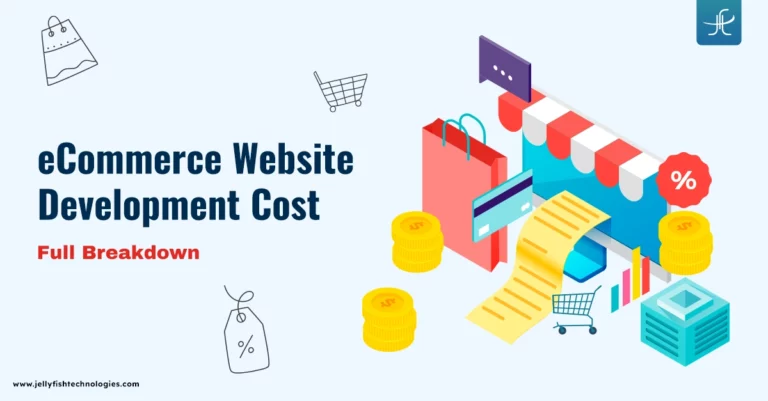The significance of E-commerce websites in today’s rapidly evolving digital world cannot be overstated. With consumers increasingly turning to online platforms for their shopping needs, having a reliable E-commerce presence is essential for businesses to thrive. It has become the need of the hour to take your e-commerce services online.
However, the establishment of a digital presence comes with a lot of challenges, of which the major one is the cost estimation of building an eCommerce platform.
The cost of developing an eCommerce website can vary significantly, depending on various factors. Understanding these factors is crucial for businesses looking to invest effectively in their online presence.
In this article, we discover the scope of eCommerce website development costs in 2024. From dissecting the essential components to exploring the influencing factors, we aim to provide you with a broad understanding of the financial aspects of building a successful eCommerce platform. Let’s embark on this enlightening journey together.
What Changed In The E-Commerce Industry in 2024?
In 2024, the e-commerce industry witnessed significant advancements driven by the integration of advanced technologies such as Artificial Intelligence (AI) and the Internet of Things (IoT).
AI-powered algorithms were increasingly deployed for personalized product recommendations, enhancing user experience and driving sales. IoT devices, ranging from smart home appliances to wearable gadgets, expanded the network of connected devices, enabling seamless interactions between consumers and e-commerce platforms.
This wider network facilitated enhanced data collection and analysis, empowering businesses to gain deeper insights into consumer behavior and preferences. Additionally, advancements in technology led to streamlined processes and increased automation, contributing to cost efficiencies throughout the e-commerce supply chain.
Consequently, the industry experienced a reduction in operational costs, making online retail more accessible and affordable for both businesses and consumers alike.
Types of eCommerce Websites
eCommerce websites serve as virtual storefronts, facilitating the buying and selling of goods and services over the Internet. Software development services in the retail sector have revolutionized the retail landscape, offering unparalleled convenience and accessibility to consumers while providing businesses with global reach and scalability.
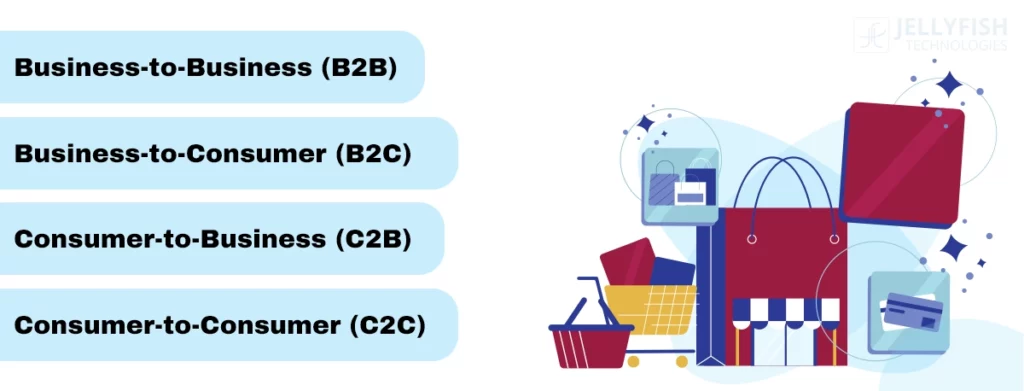
There are various types of eCommerce websites for different industries, business models, and target audiences, including business-to-consumer (B2C), business-to-business (B2B), consumer-to-consumer (C2C), and specialized platforms such as subscription-based services, online marketplaces, and digital download stores.
Each type caters to distinct market segments and operational requirements, contributing to the diverse and dynamic ecosystem of online commerce.
eCommerce platforms can be classified based on:
| Type of eCommerce Website | Description |
|---|---|
| Business-to-Business (B2B) | In B2B eCommerce, businesses sell products or services to other businesses. Examples include wholesalers selling goods to retailers or manufacturers providing components to other manufacturers. |
| Business-to-Consumer (B2C) | B2C eCommerce involves businesses selling products or services directly to consumers. This is the most common type of eCommerce platform and includes online retailers like Amazon, Walmart, and eBay. |
| Consumer-to-Business (C2B) | C2B eCommerce occurs when individuals sell products or services to businesses. Examples include freelance platforms, where individuals offer their skills or services to companies, or user-generated content platforms, where individuals license their content to businesses. |
| Consumer-to-Consumer (C2C) | C2C eCommerce involves individuals selling products or services to other individuals. This often occurs through online marketplaces where individuals can buy and sell items directly to each other, such as eBay or Craigslist. |
Why Should You Own an eCommerce Website?
The world of retail is rapidly shifting online, and owning an e-commerce website can be a game-changer for your business. With the integration of advanced technology like AI development into retail, businesses are making informed and smart decisions with data analytics services. Hence, they are growing their businesses at a rapid pace and keeping an edge over the competition. Here’s why:
1. Global Reach & 24/7 Availability
Imagine reaching millions of potential customers worldwide, 24 hours a day, 7 days a week. E-commerce removes geographical barriers, unlike physical stores. According to Statista, In 2024, retail e-commerce sales are estimated to exceed 6.3 trillion U.S. dollars worldwide, and this figure is expected to reach new heights in the coming years. E-commerce sales are projected to account for almost a quarter (22.9%) of global retail sales by 2025.
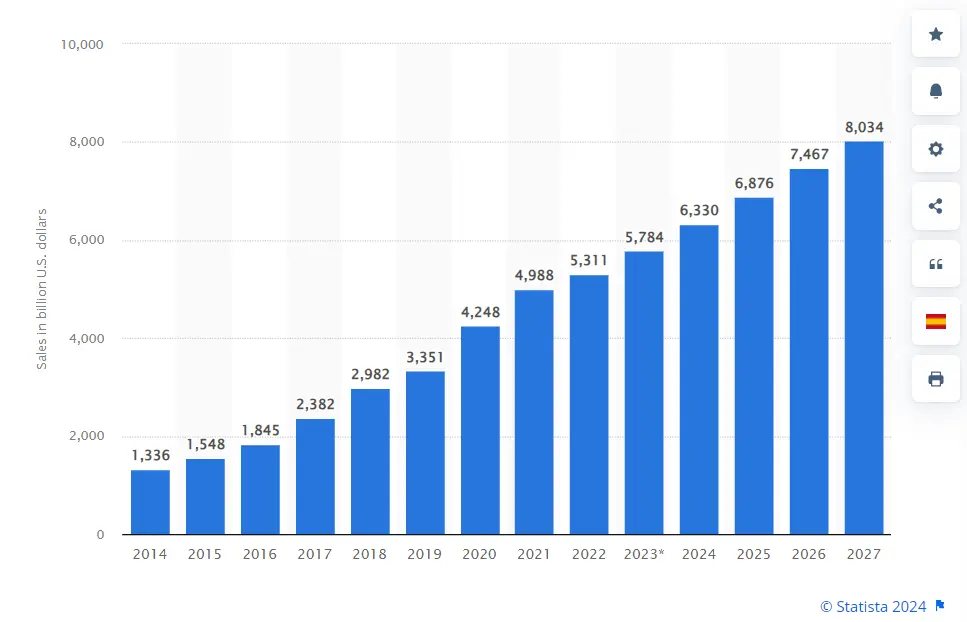
2. Lower Costs & Valuable Data
Compared to physical stores with rent, utilities, and staff, e-commerce websites have lower overhead costs, potentially boosting your profit margins. Additionally, these platforms provide valuable customer data on demographics, preferences, and buying behavior. This data goldmine allows you to personalize marketing efforts, improve product offerings, and enhance the overall customer experience, leading to greater customer satisfaction and loyalty.
Ecommerce Website Development Process
1. Custom Development vs. Pre-built Templates or Platforms
Firstly, discuss the advantages and disadvantages of custom development, such as according to functionality and scalability, versus using pre-built templates or platforms like Shopify or WooCommerce, which offer quicker deployment and cost savings.
Also, consider project complexity, long-term flexibility, and budget constraints when choosing the most suitable development approach.
2. Hiring In-house Developers vs. Outsourcing to Agencies
Compare the pros and cons of hiring in-house developers versus outsourcing development to agencies or freelancers. Companies need to augment their IT teams with certified IT experts to meet project demands and deadlines.
Highlight considerations such as expertise, resource availability, project management overhead, and cost-effectiveness.
Factors Influencing the Cost of an eCommerce Website
Understanding the cost of hosting an eCommerce website in 2024 can be a daunting task, as it involves various factors that significantly impact the overall expenses. Without a clear budget in mind, businesses risk overspending and potentially compromising on crucial features and functionalities.
So, how much does eCommerce website development cost? Let’s address the question right away:
The total cost for hosting an eCommerce website in 2024 can vary greatly, ranging from $40 to $4000 per month, in addition to setup fees ranging from $1,500 to $30,000 for website design.
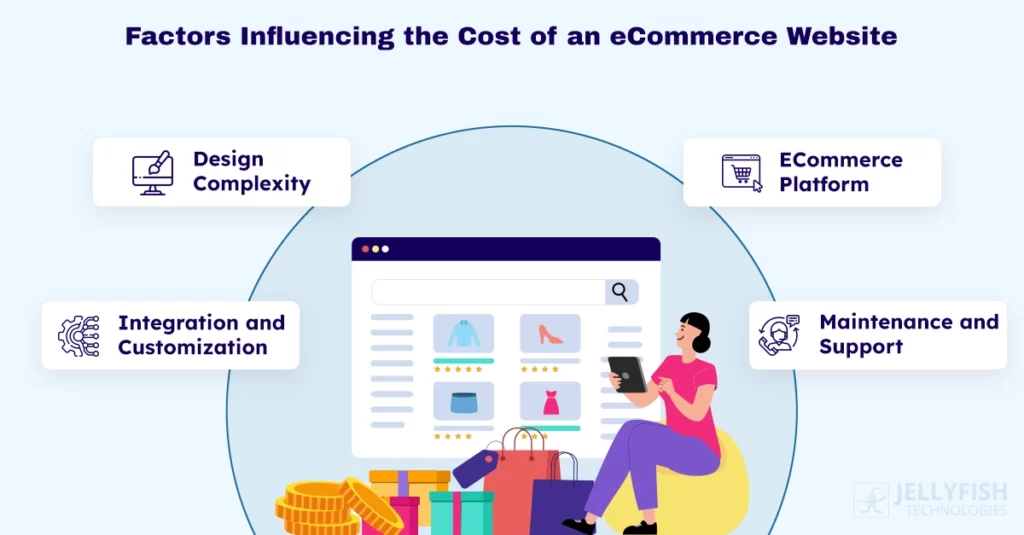
Now, why such a wide range?
Well, it all narrows down to several key factors that need to be considered before arriving at a precise quote. These factors include the size of your product catalog, the level of customization required, your projected annual sales, and your overall business needs. Custom development or modernizing software solutions comes with additional benefits, i.e. managing and breaking down costs effectively to pay for what you need.
However, determining the cost of developing such a platform can be a complex endeavor, influenced by some major and minor factors. Having a custom CRM helps e-commerce businesses to streamline the processes of the company. In this article, we’ll explore the key factors that influence the cost of software development:
1. Design Complexity
a. Simple vs. Complex Design Requirements
Explain how the complexity of design requirements, including layout, navigation, and visual elements, can impact development costs.
Discuss the importance of balancing aesthetic appeal with usability and performance considerations. To know the detailed requirements of key elements of UI/UX design, visit our blog for the same.
b. Custom Graphics and Branding Elements
Explore the cost implications of incorporating custom graphics, branding elements, and visual assets into the website design. Make use of intuitive UI/UX services to improve user satisfaction and engagement through simple, eye-catching, and intuitive user interfaces and experiences.
Emphasize the role of branding in creating a unique identity and enhancing user engagement.
2. ECommerce Platform Selection
Provide an overview of popular E-commerce platforms such as Shopify, WooCommerce, and Magento, highlighting their features, scalability, and suitability for different business requirements.
Discuss factors such as licensing fees, transaction costs, and third-party integration capabilities.
3. Integration and Customization in eCommerce
1. Cost Considerations for Integrating Third-Party Tools and Services:
Discuss the cost implications of integrating third-party tools and services such as payment gateways, shipping providers, and marketing automation solutions.
Highlight the importance of seamless integration for enhancing functionality and improving the user experience.
2. Customization Requirements Based on Unique Business Needs:
Address the need for customization to meet specific business requirements, such as inventory management, order processing, and customer relationship management.
Discuss how customization efforts can impact development timelines and budget allocations.
4. Maintenance and Support
1. Ongoing Maintenance Costs:
Explain the importance of budgeting for ongoing maintenance costs, including software updates, security patches, and performance optimization. With the integration of AI in chat support, maintenance has improved, providing 24*7 support services.
Emphasize the role of proactive maintenance in ensuring the long-term stability and performance of the E-commerce website.
2. Availability of Technical Support Services:
Highlight the importance of access to reliable technical support services for addressing issues, troubleshooting, and implementing enhancements post-launch.
Also read: Exploring the Role of AI and Machine Learning in Personalized E-Commerce
Discuss options for obtaining technical support, such as vendor support agreements, outsourcing, or in-house support teams.
Numerous steps need to be taken. For effective and affordable solutions, just assign your software development tasks to outsourcing partners. To learn more about outsourcing software development, check out our blog.
By understanding these factors and making informed decisions, businesses can effectively budget for and invest in a successful E-commerce website that meets their objectives and drives growth in the digital marketplace.
Cost Analysis of Off-the-Shelf vs Custom-Built eCommerce Platforms
When embarking on the journey to establish an eCommerce website, one pivotal decision lies in choosing between an off-the-shelf solution or a custom-built platform. Each option presents distinct advantages and drawbacks, influencing factors such as e-commerce cost, scalability, flexibility, and complexity. Let’s delve deeper into these considerations:
Off-the-Shelf eCommerce Websites
Off-the-shelf eCommerce platforms such as Shopify, BigCommerce, or WooCommerce offer a swift and relatively inexpensive means to launch an online store. These platforms come pre-equipped with a range of features for product management, payment processing, shipping, and basic SEO.
Primary cost elements included with it are:
- Subscription fee: Most Software as a Service (SaaS) platforms operate on a subscription model, with monthly fees ranging from $30 to several hundred dollars based on the chosen plan.
- Transaction fees: Some platforms levy transaction fees unless you utilize their proprietary payment processing system.
- Themes and plugins: While free themes are available, premium themes with enhanced design and functionality may cost between $100-$200. Additionally, plugins for added functionality contribute to overall costs.
- Setup and customization: While self-setup is possible, opting for professional developer assistance for an appropriate setup can incur additional expenses.
Custom-built eCommerce Websites
Custom-built eCommerce websites offer unparalleled flexibility and control, enabling the creation of a fully personalized online store.
The primary cost elements encompass:
- Web development: Engaging a web development agency or freelance developers may range from a few thousand to tens of thousands of dollars, contingent upon the site’s complexity.
- Design: Custom designs generally command higher costs compared to premade themes, with several thousand dollars required for a unique and professional design.
- Hosting and domain: Unlike SaaS platforms, custom sites necessitate separate management and payment for hosting and domain registration.
- Maintenance and updates: With custom sites, the onus lies on you to manage all updates and maintenance, either internally or through outsourced providers.
While off-the-shelf solutions offer cost-effectiveness and user-friendliness, custom-built websites present limitless customization potential. The former suits startups and small businesses with standard needs, while the latter caters to larger enterprises or those with unique requirements, albeit with higher costs and maintenance responsibilities.
Core Features And Functionalities Required For An Effective E-commerce Platform
Having a reliable and user-friendly E-commerce website is imperative for businesses to thrive in the competitive online marketplace. Building a successful eCommerce website requires more than just a visually appealing design.
It necessitates a defined platform equipped with core features and functionalities to ensure a seamless shopping experience for customers. But what are the essential components that make up an effective E-commerce platform?
Let’s look into the core features and functionalities that are indispensable for a successful online storefront:
1. Product Catalog Management
A well-organized and easily navigable product catalog is the cornerstone of any E-commerce website. From showcasing product images and descriptions to categorizing items for easy browsing, efficient product catalog management is crucial for providing a seamless shopping experience to customers.
2. Shopping Cart and Checkout Process
The shopping cart and checkout process play a pivotal role in converting visitors into paying customers. An intuitive shopping cart interface allows users to add items, adjust quantities, and proceed to checkout seamlessly. A streamlined checkout process with multiple payment options and guest checkout capabilities enhances user convenience and reduces cart abandonment rates.
3. Payment Gateway Integration
Integrating secure API integrations and reliable payment gateways is essential for facilitating smooth and secure transactions on an E-commerce website. Whether it’s credit/debit card payments, digital wallets, or alternative payment methods, seamless payment gateway integration ensures a frictionless checkout experience for customers while maintaining data security and compliance with industry standards.
4. User Account Management
Providing users with the ability to create accounts offers various benefits, including personalized shopping experiences, order tracking, and faster checkout for returning customers. User account management features such as registration, login, password recovery, and profile management enhance user engagement and loyalty.
5. Order Management System
An efficient order management system is essential for businesses to track and fulfill customer orders seamlessly. From order processing and inventory management to shipment tracking and order status updates, a robust order management system streamlines internal operations and enhances customer satisfaction by ensuring timely delivery and accurate order fulfillment.
6. Security Measures
Ensuring the security of sensitive customer data is paramount for E-commerce websites. Implementing robust security measures such as SSL encryption, PCI DSS compliance, and multi-factor authentication helps protect against data breaches, fraud, and unauthorized access. Regular security audits and updates are essential to safeguarding the integrity and trustworthiness of the E-commerce platform.
6 Primary eCommerce Website Costs
In the bustling world of online commerce, establishing a successful e-commerce website entails more than just building a visually appealing platform. It involves navigating through various expenses that are essential for creating and maintaining an effective online storefront. Let’s delve into six common costs associated with e-commerce websites:
1. Hosting
Hosting services provide the foundation for your e-commerce website, offering storage space, server resources, and bandwidth to ensure optimal performance and accessibility. The cost of hosting can vary depending on factors such as server type (shared, VPS, dedicated), storage capacity, and bandwidth requirements.
2. Payment Processing
Integrating payment processing solutions is essential for facilitating secure and seamless transactions on your e-commerce website. Payment gateway providers typically charge transaction fees and/or monthly subscription fees based on the volume and value of transactions processed through their platform. Additionally, some payment processors may impose setup fees or additional charges for certain features or services.
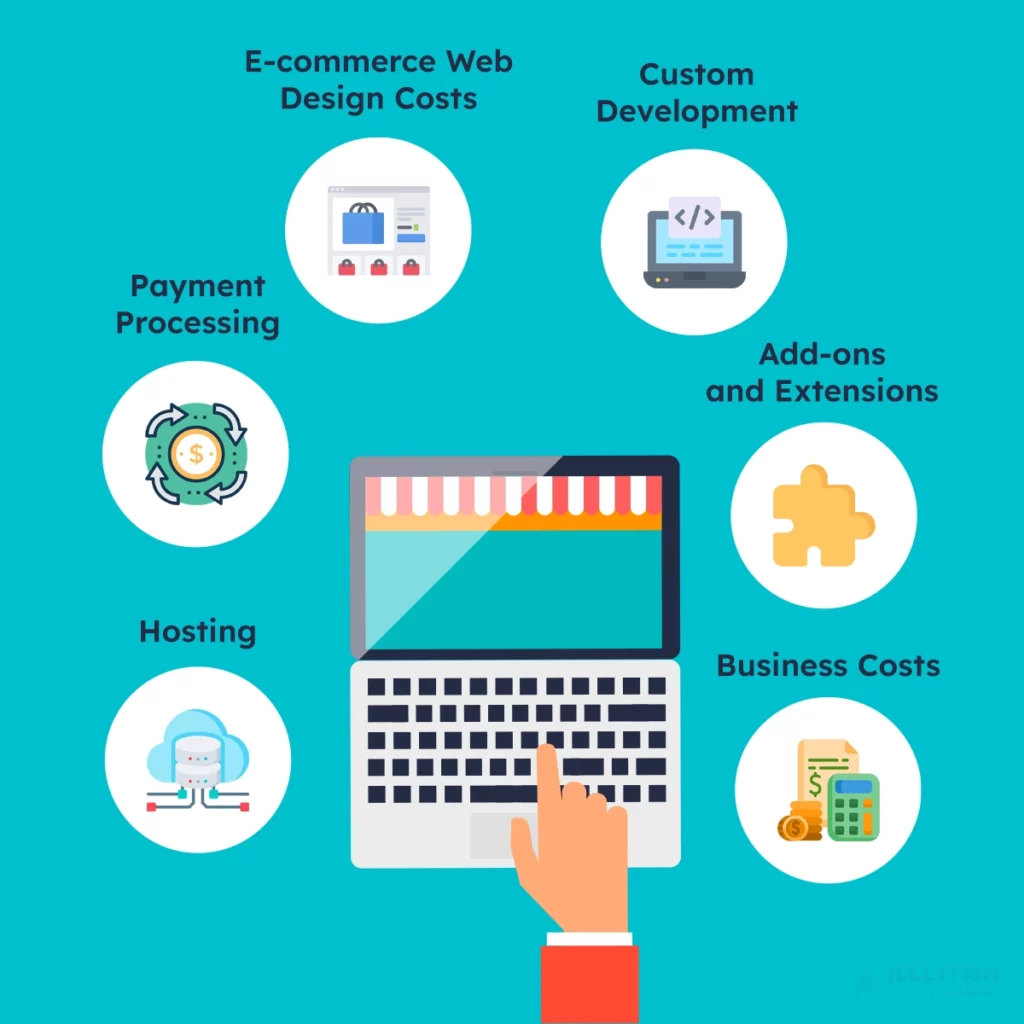
3. E-commerce Web Design Costs
Investing in professional web design services is crucial for creating a visually appealing and user-friendly e-commerce website that reflects your brand identity and effectively engages customers. Web design costs can vary depending on the complexity of design requirements, customization needs, and the level of expertise of the design team. Factors such as responsive design for mobile compatibility, branding elements, and UI/UX optimization may also impact design costs.
4. Custom Development
Custom development involves tailoring your e-commerce website to meet specific business requirements and functionality needs that cannot be achieved through off-the-shelf solutions or templates. Follow a structured approach outlined in a step-by-step guide to software development to ensure the success of your software development projects. Whether it’s developing custom software features, integrations with third-party systems, or implementing unique design elements, custom development entails additional costs in terms of development hours, programming expertise, and ongoing maintenance.
5. Add-ons and Extensions
Enhancing your e-commerce website with additional add-ons and extensions can add value and functionality to your platform, enriching the user experience and expanding your site’s capabilities. Add-ons and extensions may include features such as advanced analytics, marketing automation tools, SEO optimization plugins, and customer support integrations. While some add-ons may be free or available at a minimal cost, others may require subscription fees or one-time purchases.
6. Business Costs
Running an e-commerce business entails various operational expenses beyond website development and maintenance. These may include inventory costs, marketing, and advertising expenses, customer acquisition and retention initiatives, fulfillment, and shipping costs, as well as overhead expenses such as rent, utilities, and employee salaries. It’s essential to factor in these business costs when budgeting for your e-commerce website to ensure profitability and sustainability in the long run.
By carefully assessing your requirements, prioritizing investments, promoting cost-effective solutions, and developing trending mobile-friendly applications you can optimize your e-commerce website’s performance and drive growth in the competitive digital marketplace.
What Is The Overall Cost of Various Size E-Commerce Websites?
Your initial investment for a new eCommerce website typically ranges from $50 to $3000 per month, plus setup fees. However, let’s delve deeper into the e-commerce price breakdown:
| eCommerce Pricing Factor | Small Business | Mid-Size Business | Enterprise Organization |
|---|---|---|---|
| Website Design / Graphics | $5,000 | $15,000 | $50,000 |
| Back-End Programming | $2,000 | $25,000 | $100,000 |
| 3rd Party Integrations | $1,000 | $10,000 | $50,000 |
| Data Imports | $0 | $5,000 | $25,000 |
| Content Management System | $2,500 | $20,000 | $50,000 |
| Website Hosting | $1,000 / year | $6,000 / year | $12,000 / year |
| eCommerce Website Maintenance | $3,000 / year | $12,000 / year | $60,000 / year |
| SEO Services | $12,000 / year | $50,000 / year | $120,000 / year |
At the outset, your eCommerce venture may only require the essentials. As you begin, focus on establishing the basic infrastructure and design elements. However, as your sales expand and your business grows, it becomes imperative to reinvest in your website’s infrastructure and design to stay competitive in the market. Remember, in the world of eCommerce, investing in quality pays off, as it takes money to make money.
Furthermore, safeguard your investment by prioritizing customer satisfaction. By providing exceptional service and experiences, you can transform your customers into loyal brand advocates.
What is the Cost of Developing an E-Commerce Website?
The cost of an average eCommerce website typically falls within the range of $1,500 to $30,000. However, determining the precise amount you’ll invest in your eCommerce solution involves considering several key factors:
- The chosen type of web builder
- The level of complexity of the website
- The type of team involved in the development process
- The geographical location of the developers
Let’s look into each of these factors to understand their impact on determining the final cost of your eCommerce website.

eCommerce Website Price Breakdown by Web-Builder Type
The cost of developing an eCommerce website varies depending on whether you’re building it from scratch or utilizing web builders such as Shopify or WooCommerce. While custom websites tend to be more expensive, they provide numerous advantages for those requiring a scalable, robust, and branded platform.
| Type of Web-builder | Cost Range |
|---|---|
| DIY Platforms (e.g., Wix, Shopify) | $29 $299 per month |
| Open-source Platforms (e.g., WooCommerce, Magento) | Free $20,000+ (development & maintenance costs) |
| Custom-built Solutions | $10,000 $100,000+ (development & maintenance costs) |
Opting for a custom platform becomes necessary if you aim to integrate your eCommerce application seamlessly with your website.
Another approach to determining the cost of your eCommerce project is by assessing its complexity.
eCommerce Website Price Breakdown by Complexity
The complexity of an eCommerce platform refers to its array of user roles, functionalities, and features, as well as how they interact within the website.
Generally, smaller and simpler applications require less time to develop. Basic apps, being less complex with fewer features, functions, and user roles, demand less development time.
Below is a table illustrating how web development costs vary based on complexity.
| Complexity Level | Cost Range |
|---|---|
| Basic (few products, simple design) | $500 $5,000 |
| Moderate (medium product range, basic features) | $5,000 $20,000 |
| Complex (extensive product range, advanced features, customizations) | $20,000 $100,000+ |
Another factor to consider when pricing an e-commerce website is the type of development team involved. Let’s discuss:
eCommerce Website Price Breakdown by Team Type
When embarking on the development of an eCommerce website, selecting the right team is crucial, as it directly influences the quality, functionality, and ultimately, the success of the project.
The team type chosen for the task, whether it be a freelancer, a small agency, or a large agency, significantly impacts the cost, expertise, and resources available for the project.
Making an informed decision regarding the team type ensures the efficient execution of the eCommerce website development process while aligning with budgetary considerations and project requirements.
The table below shows the cost of developing a site of average complexity:
| Team Type | Cost Range |
|---|---|
| Freelancer | $500 $10,000 |
| Small Agency | $5,000 $50,000 |
| Large Agency | $50,000 $500,000+ |
eCommerce Website Price Breakdown by Region
The cost of developing an eCommerce website can vary significantly depending on various factors, including the region where the development takes place. Different regions have different labor costs, market dynamics, and economic factors that influence the overall expenses associated with building an eCommerce website.
Understanding how costs vary by region is essential for businesses seeking to optimize their budget and find the most cost-effective solutions for their eCommerce projects.
Let’s explore the costs of eCommerce websites defined by region to gain insights into these regional variations.
| Region | Average Cost Range |
|---|---|
| North America | $10,000 $150,000+ |
| Europe | $7,000 $100,000+ |
| Asia | $5,000 $50,000+ |
| Africa | $3,000 $30,000+ |
| South America | $4,000 $40,000+ |
Additional eCommerce Website Costs to Consider are-
- eCommerce Web Design Cost
- Payment Processing Cost for eCommerce
- Search Engine Optimization Cost for eCommerce Website
- Additional Dependables and Plugins
- Content Costs for eCommerce Website
Conclusion
By gaining a precise understanding of the various cost components, businesses can make informed decisions and allocate resources effectively. From development approach and design complexity to platform selection and ongoing maintenance, every aspect plays a crucial role in determining the overall investment required. By embracing transparency and foresight in budgeting, businesses can mitigate risks, avoid overspending, and lay a solid foundation for their eCommerce ventures.
We understand that navigating the complexities of eCommerce website development can be daunting. That’s why we’re here to offer personalized consultation and assistance according to your unique business requirements. Whether you’re a small startup looking to establish an online presence or a seasoned enterprise seeking to optimize your existing eCommerce platform, our team of experts is ready to guide you every step of the way. Reach out to us today to unlock the full potential of your eCommerce journey.
In conclusion, by embracing a strategic approach to cost management and leveraging expert guidance, businesses can embark on their eCommerce endeavors with confidence, knowing they have the necessary tools and support to succeed in the dynamic digital marketplace.

